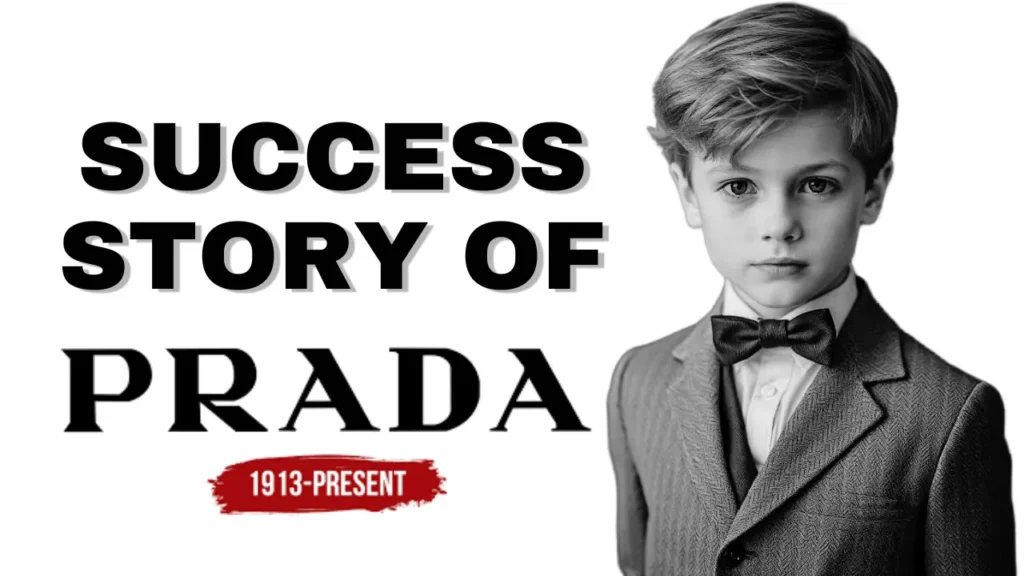Prada has evolved into a global fashion powerhouse since its humble beginnings as a small leather goods shop in Milan. The story of Prada is one of family, rivalry, innovation, and female empowerment. This blog article delves into the history of the Prada brand, exploring the key figures who have shaped its legacy and the challenges and triumphs it has faced throughout its journey.

Table of Contents
Chapter 1: Early Life
Mario Prada was born in Milan, a city renowned for its textile production, particularly silk and velvet. As industrialization swept Europe, Milan’s manufacturing prowess inspired Italian fashion designers like Bulgari, Gucci, and Ferragamo to develop unique styles. Mario Prada was at the forefront of this new wave of Italian fashion pioneers.
Mario hatched a business plan with his brother Martino to provide travel goods to a very specific demographic: the wealthy. By 1913, they were ready to launch their venture, opening a shop in Milan’s Galleria Vittorio Emanuele II, a historic four-story shopping arcade and, at the time, the most popular in Milan. This prime location was synonymous with luxury retail and fashion.
From here, Mario and Martino created Fratelli Prada, meaning “The Prada Brothers,” selling predominantly luxury travel cases, steamer trunks, and other travel goods, all fashioned from leather. Their exceptional craftsmanship quickly gained recognition. In 1919, Fratelli Prada earned a lucrative contract as the official supplier to the Italian Royal House. From then on, Prada designed the House of Savoy’s coat of arms, eternally linking the company to the Italian aristocracy. 1931, the company was renamed and incorporated simply as Prada and later as the Prada Group.
While the brand may have been popular with the Italian royalty, it still faced competition from a Tuscan brand.
Chapter 2: An Italian Rivalry
While Mario built his legacy, another designer 150 miles south did the same in Florence. Guccio Gucci established his business around the same time, creating luxury accessories for the wealthy market. However, their approaches were radically different. Gucci targeted American and Italian movie stars to advertise his products and expanded quickly into the international market, selling in hotspots like New York and London. Meanwhile, Prada refrained from the world of celebrities and instead focused on the domestic Italian market. As a result, Prada was not as widely known to the rest of the world as Gucci.
By the 1950s, with death approaching, Mario Prada was ready to pass the reins to the next generation. This was where he would be forced to compromise. Mario believed in traditional gender roles and had always envisioned handing his company to his son. Unfortunately for him, his son refused to continue the family business. He turned to Louisa, his daughter, who had always shown an interest in her father’s growing empire.
Mario died in 1958, and while he may not have had high hopes for the future of his creation, his reluctant decision to put his daughter at the company’s head would turn out to be a defining moment in the history of Prada. It ushered in an era of female leadership that expanded the business far beyond the walls of Italy and, more importantly, finally got one over on their rivals, Gucci.
Chapter 3: The Matriarchs
Louisa took charge and, for twenty years, steadily expanded the business. She ventured into different areas like ocean and airline travel but was careful not to take on too many risks, erring on caution to preserve what her father had built. When she finished her reign, the business was raking in an annual turnover of 450 thousand dollars, about three million dollars today. While this was certainly a success, Prada had a long way to go before becoming the global behemoth it is today. It would be through Mario’s granddaughter, Maria Bianchi, who was much more ambitious than her mother.
Still in her twenties, Bianchi had already lived a colorful life when she was pulled into the family business. She had been adopted by her aunt and raised in Milan. Throughout her education, she became passionately involved with civil protests, fighting for women’s rights as an active part of the Italian Communist Party. These politics stuck with her, and after high school, she studied political science, earning her PhD from the University of Milan. Maria also trained at the prestigious Teatro Piccolo for five years to become a mime. However, she was destined for an entirely different life.
By the 1970s, Maria, who had taken the name Miuccia Prada, her mother’s name, had been recruited to work in the family business in the design department for accessories. In 1978, Miuccia officially took charge of Prada. Some reports claim that she was reluctant to take charge, and the elites in the old guard weren’t convinced she had what it took to direct a brand built on timeless, conservative tastes that were averse to change. However, she would soon prove them wrong with her rigorous education and ability to combine elements of politics, philosophy, and design.
Chapter 4: Success in the 80s
Unsatisfied with keeping the Prada company solely in the leather goods business, Miuccia saw a much larger potential. The company would be in strong hands with Patricio Bertelli, a Tuscan leather businessman with whom she partnered personally and professionally. Patricio had a wealth of experience and production facilities, which were crucial in forming the basis for future expansion. Patrizio managed the business component, allowing Miuccia to work on design full-time.
Miuccia quickly developed an idea she had been experimenting with for years: she had created black waterproof backpacks using a nylon fabric called Pocone. In 1985, she used this fabric to create a Prada black nylon handbag. It quickly became a European must-have fashion accessory due to its solid build quality and impeccable design. Far from her political studies, Miuccia had found her calling. Her bag was so successful that it generated waves of copycats, boosting the value of original Pradas even more.
This opened the brand name Prada to the rest of the world, opening doors for Prada in new markets. They began increasing their network of stores, and for Miuccia, the architecture and interior design of her shop fronts were just as important as the products inside. For the first store of this new era, she employed architect Roberto Baciocchi, who grabbed attention for its distinctive light green, now called “Prada green.”
Chapter 5: An Old Rival
By the 1950s, Milan was fast becoming the fashion capital of Europe. It was close to production facilities, and the first Milan Fashion Week kicked off in 1958, fifteen years before its counterpart in Paris. In 1961, the headquarters of the international authority on fashion, Vogue magazine, was established in Milan. Miuccia Prada was the latest in a line of Milan-based designers like Gianna Versace and Giorgio Armani. Unlike them, though, Miuccia already had a powerful company under her control.
At the beginning of the 1990s, Prada launched Miu Miu, her nickname and now her new brand. It was targeted at a younger audience, making more affordable products. The company could afford to branch out more. By 1994, sales reached 210 million dollars, or 432 million today. By this time, Prada could step into Chinese, Japanese, and American markets, and the company began acquiring shares in other companies in the domestic market, too.
In 1998, Prada bought a staggering nine percent of their old rival, Gucci, which made them the company’s largest single shareholder. Patrizio Bertelli, Miuccia’s husband and business partner, had publicly insulted Gucci’s design direction in the buildup. More worrying for Gucci, Patricio had a good relationship with the head of LVMH, Bernard Arnault. Within a year, Prada sold their Gucci shares to LVMH, the biggest luxury conglomerate in the world, for a profit of more than 250 million dollars in today’s money.
LVMH attempted to take over Gucci at the time, sparking an all-out war in the fashion world. Prada’s sale raised their shares to 14.5 percent of Gucci in a tactic that had worked repeatedly. This time, though, it didn’t work. In a last-minute push for investment, Gucci issued three billion dollars of new shares and acquired 40 percent of the company through an alliance.
Prada was determined to hurt Gucci. Blocking their strategy was the next best thing if they couldn’t lead to a hostile takeover. Prada partnered with LVMH to buy out a majority share of the fashion company Fendi, which Gucci had been eyeing up. However, this rivalry didn’t make for good business. Prada’s next few acquisitions proved to be losing bets. Only the purchase of the car shoe company and the English shoemaker Church strengthened their portfolio. By then, financial disaster was already looming.
Chapter 6: 21st Century
In 2000, one of Prada’s most iconic pieces, the bowler bag, was released, instantly selling out. It was a continuation of the same products Miuccia’s grandfather had started the business with 87 years earlier, but this time, it was made for women, not men. Soon, any celebrity worth their salt was seen with a Prada bag. The company had pivoted from the Italian aristocracy to the global aristocrats: celebrities, politicians, and business people. The price of a single bag ranged from 1,000 to a thousand dollars, but it was worth the price for most.
Miuccia’s pioneered style was incredibly functional and useful compared to Prada’s competitors. With that functionality came subtle branding so that Prada products were more recognized by their form rather than by logo or excesses. One of the most important aspects of Prada’s branding is its storefronts. Mario Prada had hesitated to expand the business, and his granddaughter Miuccia was no different. The company expanded only by maintaining a high quality of architecture and design in epicenter stores.
The first one was built in 2001 in New York, and some estimates put construction costs as high as 40 million dollars. It is a one-of-a-kind building and typifies Prada’s commitment to the art world, funding exhibitions, housing collections, and creating performance spaces. Two years after the New York Soho epicenter was built, one in Tokyo popped up, covering six floors and adorned with Prada’s now trademark green glass.
However, these towering monuments to high fashion weren’t enough to save Prada from going into debt in the early 2000s. In 2005, the company was forced to sell five percent of itself to pay off debtors. By 2008, Prada was still 1.1 million euros in debt. Once allergic to mass marketing, Prada has embraced collaborations and sponsorships to return to financial stability. Prada has released glasses, a collection of fragrances, and even mobile phones with LG.
The Rolls-Royce: Success, History, Case Study
Audi Success Story: Case Study of Audi and Future of Luxury Mobility
Mercedes-Benz: World’s First Car Success Story
Ford Sucess Story: The Incredible Rise of Henry Ford
Chapter 7: The Fourth Generation
2011 Prada’s initial public offering in Hong Kong raised 2.1 billion dollars. It was a relatively modest debut compared to other fashion giants like LVMH. Five years later, Prada lost out in the fashion world to its old nemesis, Gucci, who was gaining ground among young people. However, the Prada Group is fighting back along with Miu Miu, which reported a 50% decrease in sales in 2020. Last year, total sales were 4.2 billion euros. Miuccia Prada herself has amassed a net worth of 6.9 billion dollars and is regarded as one of the most powerful women on the planet.
Mario Prada never envisioned women working in his company, let alone leading it. However, it became the most important element in transforming Prada from a niche Italian aristocratic brand to a global phenomenon in the fashion world with an uncompromising style. Under Miuccia’s leadership, Prada has combined classic and contemporary elements into its design while always maintaining practicality. The confidence instilled through her prestigious education made her perfectly suited for the task at hand, cementing the matriarchy of the Prada family.
Lucia was ready to challenge conventional fashion norms, a confidence that would push the boundaries of aesthetics, extending to architecture and the wider art world. Prada has made a permanent mark on the world. Miuccia and Patricio stepped down earlier this year and are preparing for the next generation. Their eldest son, Lorenzo, the family’s name in the future, rests in his hands. And after two generations of women, Mario Prada will finally have a male heir in charge of the company.
The Prada story is a testament to the power of vision, innovation, and the indomitable spirit of the human spirit. From its humble beginnings in Milan to its global dominance, Prada has redefined the boundaries of luxury fashion.
I hope you got the answers to your questions or queries like – Prada success story Wikipedia, Miuccia Prada success story, who is Mario Prada, What is Prada known for, Prada founder, Prada owner, Miuccia Prada net worth, Success Story Of Miuccia Prada, history of Prada and what you think about the Prada brand’s journey. Do you admire the matriarchal leadership that has shaped its success? What are your favorite Prada products or designs? Share your thoughts in the comments below!










